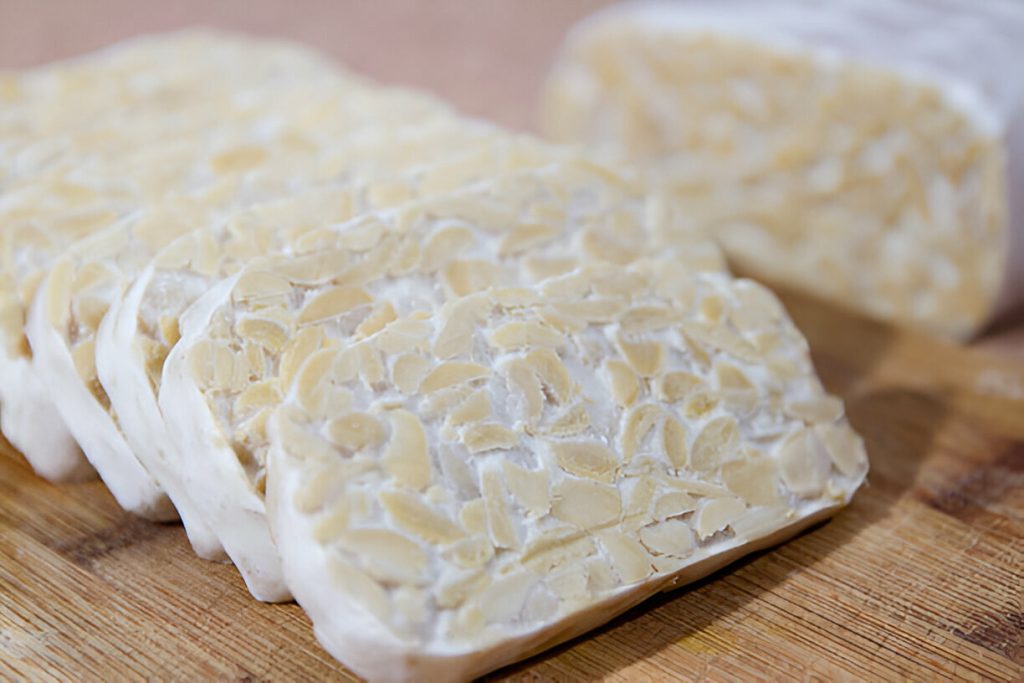Tempeh Recipe
Making tempeh at home is a rewarding experience that allows you to create a fresh, nutritious, and versatile plant-based protein. This step-by-step recipe transforms simple soybeans into a delicious block of tempeh that can be incorporated into a wide variety of dishes, bringing a satisfying and wholesome element to your meals.

Ingredients Overview
The foundation of this recipe is organic soybeans, chosen for their high quality and essential role in creating authentic tempeh.
Brown rice vinegar is used to prepare the soybeans, helping to balance their natural flavors while supporting the fermentation process. The tempeh starter, a vital component, introduces the beneficial spores necessary to develop the signature white mycelium that binds the beans into a solid block. Finally, a gallon-sized ziplock bag ensures consistent fermentation by creating a controlled environment with proper airflow.
Step-by-Step Preparation Guide
Start by soaking the soybeans in 2 litres of water overnight or for at least 12 hours. This softens the beans, making it easier to remove their skins and split them. Rub the beans gently between your hands to loosen the skins. Aim to split as many beans as possible, but it’s fine to leave a few whole or with skins. Use a colander to separate the skins from the beans, repeatedly rinsing and draining the water until most skins are removed.
Once cleaned, transfer the soybeans to a pressure cooker with 2 litres of water and cook for 12 minutes, ensuring they’re tender but still firm. Alternatively, boil the beans on medium-low heat for 45 minutes to an hour, skimming off any foam that rises to the surface. Avoid overcooking, as mushy beans will disrupt the texture of the tempeh.
Drain the cooked beans and spread them evenly on a tray lined with a clean kitchen towel. Let them steam dry and cool completely. Once cool, transfer the beans to a large mixing bowl. Stir in the brown rice vinegar, ensuring even coating. Sprinkle the tempeh starter over the beans and mix thoroughly for consistent fermentation.
Spoon the seasoned beans into a gallon-sized ziplock bag, pressing out all the air before sealing it. Lay the bag flat and spread the beans evenly, creating a uniform layer. For added consistency, gently press the bag with a chopping board. Use a toothpick to prick evenly spaced holes across the surface, about 1 inch (2.5 cm) apart, then carefully flip the bag and repeat the process.
Place the bag on a wire rack in a warm, well-ventilated location. Allow the beans to ferment for 12 to 48 hours, depending on the temperature. After 12 to 24 hours, white fuzz will begin to develop around the beans, a sign that the fermentation is progressing well. The tempeh is ready when the entire block is solid, and the soybeans are enveloped in white mycelium, typically within 36 to 48 hours.
To remove the tempeh, use a knife to carefully cut down the middle of the ziplock bag without damaging the plastic. Extract the tempeh in halves and cut it into your preferred shapes.

Recipe Tips
Ensure the fermentation area maintains a consistent warmth, ideally between 30–35°C, for the best results.
Adjust the quantity of tempeh starter slightly if you live in a colder or hotter climate to suit the environment.
Safely reuse ziplock bags by thoroughly washing and drying them after each use.
What to Serve With This Recipe
Tempeh is a versatile ingredient that pairs wonderfully with stir-fries, salads, and grain bowls. Enhance its flavor by pairing it with rich sauces like peanut satay, soy-ginger glaze, or a spicy chili oil.
Frequently Asked Questions
Can I use other legumes or grains instead of soybeans for tempeh? Yes, chickpeas, lentils, or a mix of grains can also be used to create different textures and flavors.
What should I do if my tempeh doesn’t ferment fully? Check the temperature and humidity of your fermentation space and allow additional time for the mycelium to develop.
How can I tell if the tempeh has over-fermented or spoiled? A strong ammonia-like smell or excessive black spots are signs that the tempeh has over-fermented.
Storage and Reheating Instructions
Store freshly made tempeh in the refrigerator for up to 4 days, keeping it wrapped to prevent drying out. For longer storage, freeze the tempeh for up to 3 months. To use frozen tempeh, thaw it in the refrigerator overnight before cooking to maintain its texture and flavor.
Homemade tempeh is a fantastic addition to any plant-based kitchen. Experiment with marinades, grilling techniques, or baking methods to explore its versatility. Use it as a protein-packed centerpiece or as an ingredient to elevate global cuisines like Indonesian nasi goreng or Mexican tacos. Tempeh’s unique texture and flavor are sure to inspire countless culinary creations.

Ingredients
500g organic soybeans
4 litres water
3 tbsp brown rice vinegar
1 heaped tsp tempeh starter
1 gallon-sized ziplock bag
Instructions
Prepare the Soybeans
Begin by soaking the soybeans in 2 litres of water for at least 12 hours or overnight to soften them. Once soaked, rub the soybeans between your hands to loosen their skins and split them. Aim to split as many beans as possible; a few whole beans and leftover skins are acceptable.
Place a colander in a sink or large bowl. Use your hands to agitate the water, causing the skins to float to the surface. Gently pour off the water and skins into the colander. Repeat this process with fresh water until most of the skins are removed.
Transfer the soybeans to a pressure cooker with 2 litres of water and cook for 12 minutes, ensuring they are tender but not mushy. Alternatively, boil the soybeans in a pot over medium-low heat for 45 minutes to 1 hour, skimming off any foam that forms. Avoid overcooking to prevent the beans from becoming too soft.
Drain the cooked soybeans and spread them on a tray lined with a clean kitchen towel. Spread them evenly and allow them to steam dry and cool completely. Once cool, place the soybeans in a large, clean bowl. Stir in the brown rice vinegar thoroughly, ensuring all beans are coated. Sprinkle the tempeh starter evenly over the soybeans and mix well to distribute it uniformly.
Bagging the Soybeans
Prepare a gallon-sized ziplock bag. Spoon the prepared soybeans into the bag, pressing out all the air before sealing it. Lay the bag flat on a hard surface and use your hands to spread the soybeans into an even layer. To ensure uniformity, place a chopping board on top of the bag, move it gently, and press down lightly.
Using a toothpick, prick evenly spaced holes across the surface of the bag, approximately 1 inch (2.5 cm) apart. Carefully flip the bag over and repeat the pricking process on the other side.
Leaving to Ferment
Set up a wire rack in a warm, well-ventilated location. Slide the bag of soybeans onto the rack. Allow the beans to ferment for 12 to 48 hours, depending on the temperature of your environment. After 12 to 24 hours, you will notice white fuzz beginning to grow.
The tempeh is ready when the entire bag becomes a solid block, and the soybeans are fully enveloped in white mycelium. This typically takes 36 to 48 hours.
To remove the tempeh, use a knife to cut the ziplock bag carefully down the middle without slicing through the plastic, allowing you to reuse the bag. Gently extract the tempeh one half at a time.
Storage Instructions
Cut the tempeh into your preferred shapes. Store it in the refrigerator for up to 4 days. Be aware that the tempeh will continue fermenting in the fridge, slowly intensifying in flavor. Eventually, it will over-ferment and spoil.
If you’re not planning to use the tempeh immediately, freeze it for up to 3 months to maintain its quality and freshness.

Tempeh Recipe
Ingredients
- 500 g organic soybeans
- 4 litres water
- 3 tbsp brown rice vinegar
- 1 heaped tsp tempeh starter
- 1 gallon-sized ziplock bag
Instructions
Prepare the Soybeans
- Begin by soaking the soybeans in 2 litres of water for at least 12 hours or overnight to soften them. Once soaked, rub the soybeans between your hands to loosen their skins and split them. Aim to split as many beans as possible; a few whole beans and leftover skins are acceptable.
- Place a colander in a sink or large bowl. Use your hands to agitate the water, causing the skins to float to the surface. Gently pour off the water and skins into the colander. Repeat this process with fresh water until most of the skins are removed.
- Transfer the soybeans to a pressure cooker with 2 litres of water and cook for 12 minutes, ensuring they are tender but not mushy. Alternatively, boil the soybeans in a pot over medium-low heat for 45 minutes to 1 hour, skimming off any foam that forms. Avoid overcooking to prevent the beans from becoming too soft.
- Drain the cooked soybeans and spread them on a tray lined with a clean kitchen towel. Spread them evenly and allow them to steam dry and cool completely. Once cool, place the soybeans in a large, clean bowl. Stir in the brown rice vinegar thoroughly, ensuring all beans are coated. Sprinkle the tempeh starter evenly over the soybeans and mix well to distribute it uniformly.
Bagging the Soybeans
- Prepare a gallon-sized ziplock bag. Spoon the prepared soybeans into the bag, pressing out all the air before sealing it. Lay the bag flat on a hard surface and use your hands to spread the soybeans into an even layer. To ensure uniformity, place a chopping board on top of the bag, move it gently, and press down lightly.
- Using a toothpick, prick evenly spaced holes across the surface of the bag, approximately 1 inch (2.5 cm) apart. Carefully flip the bag over and repeat the pricking process on the other side.
Leaving to Ferment
- Set up a wire rack in a warm, well-ventilated location. Slide the bag of soybeans onto the rack. Allow the beans to ferment for 12 to 48 hours, depending on the temperature of your environment. After 12 to 24 hours, you will notice white fuzz beginning to grow.
- The tempeh is ready when the entire bag becomes a solid block, and the soybeans are fully enveloped in white mycelium. This typically takes 36 to 48 hours.
- To remove the tempeh, use a knife to cut the ziplock bag carefully down the middle without slicing through the plastic, allowing you to reuse the bag. Gently extract the tempeh one half at a time.
Storage Instructions
- Cut the tempeh into your preferred shapes. Store it in the refrigerator for up to 4 days. Be aware that the tempeh will continue fermenting in the fridge, slowly intensifying in flavor. Eventually, it will over-ferment and spoil.
- If you’re not planning to use the tempeh immediately, freeze it for up to 3 months to maintain its quality and freshness.

